Jan Borchert, Current Hydro and Dana Hall, Esq.
So far we’ve considered the option of owning an off-grid micro-hydropower system and looked at different ways of paying for the hydropower installation, in our economics and financing post. But let’s summarize and detail the actual advantages of the ownership model and discuss the responsibilities associated with owning your own hydropower system directly.
Advantages of Ownership
The main advantage of the ownership model is its simplicity relative to the PPA and CDG financing models. Assuming the site owner has the cash or access to financing to pay for construction, this model allows the site owner to use the electricity output exactly as they wish as well as meet their environmental goals.
The micro-hydrosystem can also be a hedge against escalating energy prices, which are volatile and can fluctuate unpredictably. Self-financing a micro hydropower project allows the site owner to always know what their electricity will cost and exactly where it is coming from – two factors other utility customers cannot claim for themselves.
Another advantage of the ownership model is the broad applicability; the goal is matching generation and consumption by design. The amount of water necessary to power a single home can be minimal – small streams that flow continuously throughout the year can be enough to satisfy limited energy needs and can be combined with battery backup. Additional flow volumes could incentivise the site owner to switch from propane fueled heating or cooking to (renewable) electric.
But owning your micro-hydrosystem comes with responsibilities – and these are not insignificant.
Responsibilities of Ownership
The site owner must understand the environmental impacts of hydropower generation and be prepared to mitigate and address environmental issues as they arise. In many cases hydro-site owners would want support of an experienced hydropower developer to assist in this process.
The operations of a microhydro plant are not necessarily complicated, however like any other electricity generation source, the plant must be operated safely.
Because hydroelectric facilities impact natural waterways, the owner of a generation plant is subject to regulatory oversight – on a local, state and/or federal level. A site owner must be comfortable navigating the regulatory, permitting and dam safety requirements of their facility, and must be prepared to meet the ongoing demands of inspections, system monitoring and reporting requirements that may be imposed by federal or state agencies. Owners of dams might already be used to communicating with regulatory agencies like NYSDEC’s Dam Safety and to complying with inspections and safety assessment requirements. These responsibilities can be handled by a service contract with a qualified hydroelectric company or developer.
Next Steps
Are you ready take on those responsibilities? The reward could be energy autonomy and actively fighting climate change by making your own consumption 100% renewable. But if you think you can do more, and generate more energy than what you use yourself, consider community distributed generation (CDG) or power purchase agreements (PPA), and follow the links in our financial models overview post.
Or download our full Microhydro Ownership Model report.


No responses yet